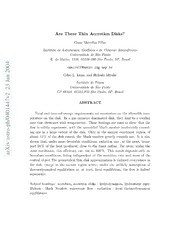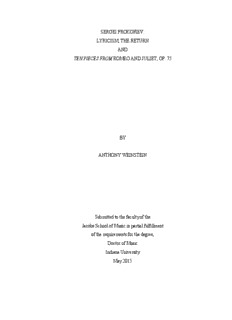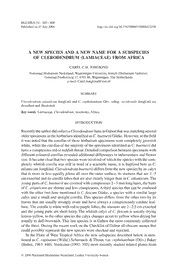
Preview Are there thin accretion disks?
Are There Thin Accretion Disks? Cesar Meirelles Filho Instituto de Astronomia, Geof´ısica e de Ciˆencias Atmosf´ericas Universidade de S˜ao Paulo R. do Mat˜ao, 1226, 05508-090 S˜ao Paulo, SP, Brasil 4 0 cmeirelf@astro.iag.usp.br 0 2 Celso L. Lima, and Hideaki Miyake n a J Instituto de F´ısica 3 Universidade de S˜ao Paulo 2 CP 66318, 05315-970 S˜ao Paulo, SP, Brasil 2 v 7 4 ABSTRACT 4 1 0 Total and internal energy requirements set constraints on the allowable tem- 4 0 perature on the disk. In a gas pressure dominated disk, they lead to a cooling / h rate that decreases with temperature. These findings are used to show that the p - flow is mildly supersonic, with the azimuthal Mach number moderately exceed- o ing one in a large extent of the disk. Only in the narrow outermost region, of r t s about 12% of the disk extent, the Mach number greatly exceeds one. It is also a : shown that, under most favorable conditions, radiation can , at the most, trans- v i port 20% of the heat produced, close to the inner radius. Far away, under the X same conditions, this efficiency can rise to 100%. This result depends only on r a boundary conditions, being independent of the accretion rate and mass of the central object.The geometrical thin disk approximation is violated everywhere in the disk, except in the narrow region where, under the unlikely assumption of thermodynamical equilibrium or, at least, local equilibrium, the flow is indeed supersonic. Subject headings: accretion, accretion disks - hydrodynamics, hydrostatic equi- librium - Mach Number, supersonic flow - radiation - local thermodynamical equilibrium – 2 – 1. Introduction In the last 30 years, accretion disks have played a major role in theoretical astrophysics. Part of this is due to the growing evidence of their presence in almost every astrophysical environment. However, it would be unfair do not recognize that this popularity is also due to physical picture of an accretion disk set forward by Shakura & Sunyaev (1973) α-standard model. The simplicity of the arguments that have led to the construction of this model is quite striking, such that, despite some drawbacks after the long time in the road, some authors keep using it as their main tool to explain data. However, the model having thinness and hydrostatic equilibrium as one of the main assumptions in its foundations, was meant to apply under very specific conditions. These certainly would exclude disks with very high accretion rates, or radiative pressure dominated disks. As a matter of fact, in that situation the disk would be thermal and secularly unstable (Lightman & Eardley 1974). According to the picture given by the standard model, the region exposed to swelling or instability would be the innermost one, which would exist whenever the radiation pressure exceeds the gas pressure. In other words, for high accretion rates. Another difficulty of the model is its impossibility of reproducing the correct transonic nature of the flow close to the horizon (Chakrabarti 1990). During quite a long time these two issues have been a major concern of the research in the area. Among models aiming to develop alternative accretion disk models, it is worth mentioning Paczynski & Wiita (1980) model which replaced the usual assumption of local energy balance by a global energy requirement, under theassumption ofcriticalradiative flux. Unquestionably, oneofthemain contributions of this work was the pioneering introduction of a pseudo Newtonian potential which simulates relativistic effects without any resource to a burdensome mathematics. At that time, the development of a theory of geometrically thick accretion disks around black holes has been undertaken by Abramowicz et al. (1978); Kozlowzki et al. (1978); Jaroszynski et al. (1980); Begelman & Meier (1982). Progress, concerning the transonic nature of the flow, came in a much slower way through the contributions from Kozlowzki et al. (1978); Liang&Thompson (1980);Paczynski &Bisnovatyi-Kogan(1981);Loska (1982);Muchotrzeb (1983); Abramowicz & Kato (1989). Since the flow has to be continuous, the solution that incorporates the transonic nature of the flow, close to the horizon, should match the solution far away, where, supposedly, the disk is geometrically thin and Keplerian. However, this matching introduces some arbitrariness, such as matching radius, and the matching of the radial and angular velocities. The problem here is the angular momentum distribution, which, close to the horizon, is highly dependent upon the matching radius (Chakrabarti 1996). Once this radius is determined, the angular momentum follows practically constant inside the horizon, a fact which suggests null boundary condition assumption for the torque (Muchotrzeb 1983). Besides, if one adopts a more realistic model of disk, allowing for – 3 – dissipation, thesituationmaybecome muchmorecomplex. This isduetothetopologyofthe solutions near the critical and subcritical points, both of them occurring in dissipative flows. Critical points satisfy regularity conditions in the form of algebraic constraints, while for the subcritical points they are given by integral requirements. In determining the character of the solution near these points, the role of the viscosity is quite decisive, such that there is a critical value of α above which no stationary accretion is possible (Muchotrzeb 1983), a question contested by Matsumoto et al. (1984) and Abramowicz & Kato (1989). Clearly, the matching of an “inner disk” with an “outer disk” is highly dependent on what kind of disk one assumes as an outer disk, that is to say, geometrically thin or not, a fact that may be seen in the works of Liang & Thompson (1980) and Loska (1982). Recently, these issues have been revived, connected with the question of “no torque” inner boundary condition (Krolik 1999; Gammie 1999; Agol & Krolik 2000; Afshordi & Paczynski 2003). As argued by Afshordi & Paczynski (2003), the no torque inner boundary condition applies whenever the disk thickness is small everywhere. However, results based on semianalytical and numerical work employing advective dominated accretion flows (ADAF) and convective dominated accretion flows (CDAF) show that accretion disks are thick for very high and very low accretion rates (Ball et al. 2001). Thinness would occur only for moderate accretion rates (0.01 L/L 0.1). It seems that, in order to bypass the issue Edd ≤ ≤ of thermal balance, one adopts the simplifying assumption of disk thinness. This is not justified a priori, because even numerical simulations yield relatively thick outer boundary, not far away from the inner one (Afshordi & Paczynski 2003). However, these simulations suffer from limitations, one of them being not including cooling processes. In the literature, alledgedly, the assumption of highly supersonic character of the Keplerian flow is used as the argument for the disk thinness. This is, for sure, intuitive, but, by no means, unquestionable. Somehow, it seems that thinness is favored by the usual assumption of local equality between heatproductionandcoolingbyradiation,whichoverlookstheproblemofenergyconservation in the disk. One of the advantages of doing so is to render the problem algebraic, rather than differential , non local. In the solutions to the disk equations, the α parameter doesn’t enter with a high power (Frank et al. 1992), which due to its inherent uncertainty, is very interesting. At this point, we realize how decisive the use of the geometrical thinness, as a boundary condition, is in determining the structure of the whole disk. If cooling of the disk is not efficient, most of the viscously produced heat is stored as proton internal energy and advected with the flow. The temperature tends to the virial value and the height scale of the disk will be comparable to the radial distance. More important, the internal energy of the plasma approaches the rest energy and, at the inner radius, the sound velocity is much greater than the radial velocity, being a substantial fraction of the light velocity. Since the gas only cools after passing through the sonic point (Muchotrzeb 1986), the sonic velocity – 4 – keeps growing till the sonic point which, in that situation, will be closer to the hole. Though the picture we have given may be incomplete, it seems that, somehow, the importance of the disk being thin or not has been overlooked. To justify this very pertinent point, we would like to stick on the conclusions by Afshordi & Paczynski (2003) and on the possibility, cast by them, of non existence of thin geometrical disks in nature. We, therefore, propose to study, in a more detailed way, the geometrical thin disk assumption. Our procedure will be to use, from the very beginning, energy requirements constraining both the temperature, the height scale of the disk, viscous heating, and cooling of the disk. This, certainly, is a global requirement that avoids the usual assumption of local equality between viscous heat production and cooling. Since the picture of geometrical thin disk is so profoundly rooted in our minds, in this work we shall focus our attention only on that. The plane of the paper is as follows. Section 2 presents the system we are considering, the assumptions and the disk equations, including an outline of the ingredients to relate angular momentum transport and dissipation to the density and radial velocity. In section 3, the totaland internal energy equations are handled in such a way as to lead to an equation to the temperature of the disk. In section 4, some approximations are made in order to solve the equation for the temperature in conditions similar to those where the standard model is supposed to apply; the main differences between our solution and the standard one are emphasized. Insection5,generalconsiderationsabouttheradiativetransferproblemlinkthe results to specific radiative mechanisms. In section 6, the flow regimes that may emerge are discussed in the context of different boundary conditions. In section 7, the main conclusions are drawn. 2. The System And The Disk Equations The system we consider is a disk around a primary compact object (a neutron star, a black hole), of mass M. Self gravitation in the disk is negligible. Working in a reference frame tied to the center of mass of the compact object, a point on the disk is at a distance R from the center and has coordinates (x, y, z) or (r, φ, z). Of course, R = (r2 +z2). For the moment, we shall use Newtonian gravitation, and the potential apt the point (r, φ, z) is GM Ψ = , − (r2 +z2) G being the gravitational constant. p – 5 – For the φ component of the velocity we will assume a Keplerian profile. Therefore, we shall write V = rΩ , φ k where Ω is the Keplerian angular velocity, k GM Ω = . k r3 r Since we are assuming the disk in hydrostatic equilibrium, dP 2 = ρΩ z, (1) dz − k where ρ is the density and P is the pressure. Now, writing P = P +P , g r where k B P = ρ T g m H is the gas pressure, T is the temperature, and F ρσ ℓ r T P = r c m H is the radiative pressure. F is the radiative flux, ℓ is the semi-height scale of the disk, k r B is the Boltzmann constant, m is the Hydrogen mass, c is the velocity of light, and σ is H T the Thompson cross section for electron scattering. Assuming constant density along z, and taking the average over z in equation (1), yields Ω 2ℓ2 k F σ ℓ k B r T = T + . (2) 3 m c m H H The continuity equation is written as M˙ = 4πrℓV ρ, (3) r − – 6 – where M˙ is the accretion rate, and V is the radial velocity. r Now, we need to work out some relations between angular momentum transport and dissipation to obtain the usual expressions for the density and radial velocity. If J˙ , J˙ and in 0 J˙ are, respectively, the inwards angular momentum transport (per unit time), the rate at out which the angular momentum flows into the central compact object and the outwards flux of angular momentum, we have J˙ = J˙ +J˙ , (4) in 0 out and we may write J˙ = M˙ √GM r, (5) in ˙ ˙ J = M GM r (6) 0 1 and p J˙ = 2πrℓτ , (7) out rφ where τ is the stress tensor given by rφ τ = 2ησ , (8) rφ r,φ − σ being the rate of strain tensor, given by r,φ r ∂Ω k σ = . (9) r,φ −2 ∂r Then, the angular momentum conservation may be written as M˙ √GM r = M˙ GM r +2πrℓτ . (10) 1 rφ p In the above equation, we have assumed null boundary condition for the torque at the inner radius r = r . This yields for the energy dissipation, 1 3 GM M˙ r 1/2 + 1 q = 1 , (11) 8π r3 − r (cid:18) (cid:19) (cid:16) (cid:17) – 7 – and for the density 3 M˙ r 1/2 1 ρ = 1 . (12) 8π Ω ℓ3 − r k (cid:18) (cid:19) (cid:16) (cid:17) 3. Energy Conservation In The Disk The equation for the total energy conservation in the disk, as the matter flows from r 2 to r, may be written as d 1 dΨ 2 ρ V +ξ v Pδ v = ρv Λ, (13) Φ k ik i k dx 2 − − dx − k (cid:18) (cid:18) (cid:19) (cid:19) k where ξ is the total internal energy, Λ is the amount of energy per unit volume that leaves the system. Assuming the system is cooled by radiation, we may write dF r Λ = . (14) dz Inserting this expression into equation (13) and using the equation of continuity, we obtain 1 Ω 2ℓ2 GM r M˙ V2 +ξ + k = M˙ 4π rF dr. (15) Ψ r 2 3 r − (cid:18) (cid:19) Zr2 Finally, assuming uniform viscous heat production along z, we write the internal energy equation as d dv dF q+ k r (ρξ) = P + . (16) dt − dx − dz ℓ k Now, making the approximation dF F r r , dz ≈ ℓ we solve for F in equations (15) and (16), and equate the results to obtain r d P ℓ d M˙ d 1 Ω 2ℓ2 M˙ GM + 2 k ℓV (ρξ) (rV )+q = V +ξ + . (17) − r dr − r dr r −4πr dr 2 Ψ 6 − 4π r3 (cid:18) (cid:19) – 8 – This is the final energy equation for the disk, which has to be solved, together with the hydrostatic equilibrium equation, to obtain the temperature profile along the disk. It should be remarked that its deduction has been achieved with no further assumption concerning the flow regime, i.e., supersonic or subsonic. We have, however, neglected terms of order of V2, and haven’t considered transport of radiation along the radial direction. r 4. The Solution To The Energy Equation In the following we shall be solving equation (16) with the main concern to find out if there are geometrical thin solutions for the disk. It is believed, under the α-standard prescription, that far away from the inner edge, in region dominated by gas pressure, the disk is geometrically thin. Therefore, the following analysis is meant to this region. In other words, we shall assume r >> r , and P >> P , which implies 1 g r Ω 2ℓ2 k k B T , 3 ≈ m H and Ω2ℓ2 ξ k . ≈ 2 Therefore, we may write 1/2 ˙ 2 3m M Ω H k ρξ , ≈ 26π2k αT1/2 (cid:18) B(cid:19) k T B V α , r ≈ −m rΩ H k 1 P ℓ M˙ Ω , k ≈ 4πα k 3/2 T3/2 ℓV √3 B α , r ≈ − m rΩ 2 (cid:18) H(cid:19) k and k T B rV α , r ≈ − m Ω (cid:18) H(cid:19) k which, inserted into equation (17), yields dT 14T 8m GM H = , (18) dr − 11 r −11k r2 B – 9 – the solution being 14 mH GM T = Ar11 +0.32 . (19) k r B Using equations (15) and (19), we may write for the radiative flux, 3 GM M˙ 70k M˙ B F = A. (20) r 40π r3 − 88πm r8/11 H Equation (20) can be cast in a much more interesting form if we use equation (19) to express the constant A. We, then, obtain M˙ 29 GM 70k B F = T , r 8πr2 11 r − 11m (cid:18) H (cid:19) or M˙ 29 GM 70 2 2 F = Ω ℓ . (21) r 8πr2 11 r − 33 k (cid:18) (cid:19) The first term in this equation is, practically, the same one that comes from usual accretion disk theory, i.e., 3 GM M˙ . 8π r3 The second, that doesn’t appear in the usual theory, displays the effect of the temperature, or the height scale: the hotter, or the thicker, the less it emits. It should be remarked that the largest temperature is 29m GM H T = . M 70k r B In the standard formulation, one assumes equality between heat production and cooling by radiation. Since the energy produced due to viscous dissipation, q+, is independent of the height scale, no matter how thin or thick the disk may be, it always adjust itself to get rid of this energy. As compared to this, the present formulation constitutes an improvement: it is clearly seen that, if the disk thickens, it starts dimming. – 10 – 5. Radiation, Electronic Temperature and Height Scale If we write the energy exchange between protons and electrons as 3 ρk (T T ) i e F = − , (22) ep 2m t H ep and equate it to the flux given by equation (21), we obtain the time protons and electrons need to reach thermal equilibrium, 3 T e t 1 t , ep dyn ≈ α − T (cid:18) i(cid:19) t being the dynamical time. We shall assume α << 1, and t >> t . dyn ep dyn The temperature we have obtained, due to our starting assumption, has to be identified with the ion temperature. Clearly, this conclusion breaks down when there is an abundant pair production and the pairs dominate the pressure. In such a situation, it has to be identified with, what we improperly call, the equivalent temperature, which we shall define at the right time. To know the electronic temperature, we should assume a specific radiation mechanism. Therefore, in the following, we shall make general considerations to link our previous results to the radiative transfer problem. In our approach, we shall try, to make a formulation not depending, as much as possible, on the values of the accretion parameters. Our starting point is to know the optical depth for thermal bremsstrahlung absorption, τ . By definition (Frank et al. 1992), ab τ = 6.22 1022ρ2T−7/2ℓ. ab × e We should expect τ decreasing as we come close to the hole. Then, in the inner region, the ab disk emits thin bremsstrahlung, and the flux is (Rybicki & Lightman 1979), F = 5 1020ρ2T−1/2ℓ. (23) × e This yields M˙ 9 −59 17 5 τ 1.38 10 r ab ≈ × α16M11 10 (r in units of Rg). 2 Finally, we obtain the electron scattering optical depth, ˙ 0.225M τ 17r−1/2. sc ≈ α M 10
The list of books you might like

The 48 Laws of Power

Mind Management, Not Time Management

Can’t Hurt Me: Master Your Mind and Defy the Odds

The Subtle Art of Not Giving a F*ck

King, Stephen - Elevation

Attitudes, Personality and Behavior (2nd Edition)

BY ANTHONY WEINSTEIN

Greek Government Gazette: Part 2, 2006 no. 518

NOTAS SOBRE A TEORIA DOS PRINCÍPIOS DE ROBERT ALEXY Natália Braga Ferreira NOTES ...

Greek Government Gazette: Part 4, 2006 no. 495

Reiki for Dummies

Tomato container gardening: 7 easy steps to healthy harvests from small spaces

Hermanas de sangre

understanding the basics of ANOVA

Process and Plant Safety

CACFP 2014 Manual PDF Copy.pdf - Alabama State Department of

by Retired Chief Ashton Syfrett

bÐ

By Rima Abou Khreibi Student ID number: 110087

Greek Government Gazette: Part 2, 2006 no. 1777

Greek Government Gazette: Part 2, 2006 no. 1923



